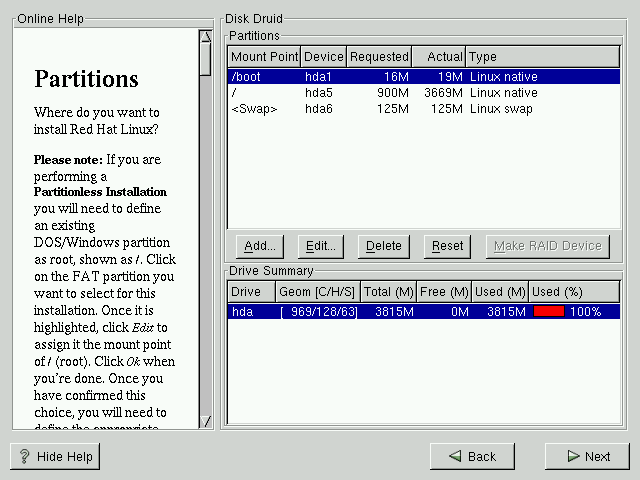Manually Partitioning Your System
If you chose Automatic Partitioning, please skip to the section called Network Configuration.
For information concerning fdisk, refer to the Official Red Hat Linux Reference Guide on the Documentation CD.
Now it's necessary to let the installation program know where it should install Red Hat Linux. This is done by defining mount points[1] for one or more disk partitions in which Red Hat Linux will be installed. You may also need to create and/or delete partitions at this time (refer to Figure 5-8).
 | Please Note |
|---|---|
If you have not planned how you'll set up your partitions, refer to the partitioning appendix in the Official Red Hat Linux Reference Guide. As a bare minimum, you'll need a root partition of 900M, and a swap partition of 16 MB. |
The partitioning tool used in Red Hat Linux 7.0 is Disk Druid. With the exception of certain esoteric situations, Disk Druid can handle the partitioning requirements for a typical Red Hat Linux installation.
Unless you have a reason for doing otherwise, we recommend that you create the following partitions:
A swap partition (at least 16MB) -- Swap partitions are used to support virtual memory. In other words, data is written to a swap partition when there is not enough RAM to store the data your system is processing. If your computer has 16MB of RAM or less, you must create a swap partition. Even if you have more memory, a swap partition is still recommended. The minimum size of your swap partition should be equal to the amount of RAM in your system or 16MB (whichever is larger). In Disk Druid, the partition field for swap should look similar to:
<Swap> hda2 125M 125M Linux swap
A /boot partition (16MB, maximum) -- The partition mounted on /boot contains the operating system kernel (which allows your system to boot Red Hat Linux), along with files used during the bootstrap process. Due to the limitations of most PC BIOSes, creating a small partition to hold these files is a good idea. This partition should be no larger than 16MB. In Disk Druid, the partition field for /boot should look similar to:
/boot hda1 16M 19M Linux native
A root partition (900MB-1.7GB) -- This is where "/" (the root directory) resides. In this setup, all files (except those stored in /boot) reside on the root partition. A 900MB root partition will permit the equivalent of a workstation-class installation (with very little free space), while a 1.7GB root partition will let you install every package in Red Hat Linux. In Disk Druid, the partition field for / should look similar to:
/ hda2 900M 3669M Linux native
Problems When Adding a Partition
If you attempt to add a partition and Disk Druid can't carry out your request, you'll see a dialog box listing partitions that are currently unallocated, along with the reason they could not be allocated. Unallocated partition(s) are also displayed on Disk Druid's main screen (though you may have to scroll through the "Partitions" section to see them).
To fix an unallocated requested partition, you must move the partition to another drive which has the available space, resize the partition to fit on the current drive, or delete the partition entirely. Make changes by selecting a partition and using the Edit button or by double-clicking on the partition.
Choose Partitions to Format
Choose partitions that you would like to format. All newly created partitions should be formatted. Any existing partitions that contain data you no longer need should also be formatted (see Figure 5-9).
Checking for bad blocks can help prevent data loss by locating the bad blocks on a drive and making a list of them to prevent their future use. If you wish to check for bad blocks while formatting each filesystem, please make sure to select the check for bad blocks option.
 | Please Note |
|---|---|
Selecting check for bad blocks may dramatically increase your total installation time. Since most newer hard drives are quite large in size, checking for bad blocks may take a while depending on the size of your hard drive. |

